How Do Different Methods for Generating Future Weather Data Affect Building Performance Simulations? A Comparative Analysis of Southern Europe
Abstract
:1. Introduction
2. Materials and Methods
2.1. Future Weather Data for Building Simulation
- CCWorldWeatherGen. Version 1.9 of this free online tool was used in this work, which employs the HadCM3 climate model, developed by the Sustainable Energy Research Group of the University of Southampton [27]. It uses the morphing methodology to produce EPW future weather data files from original TMY files. In this research, two data sets for the time slices 2041–2070 (2050 scenario) and 2071–2100 (2080 scenario) were generated, morphed from the International Weather for Energy Calculation (IWEC) TMY file of Seville [28].
- Meteonorm. Two versions of this software were used: v7, which employs the HadCM3 climate model, and v8, whose update involves the use of the RCP8.5 scenario. Both versions of this software were developed by Intersolar Europe [29]. This software is classified within the stochastic weather generators (another method for statistical downscaling that implements computer algorithms). These generators rely on a statistical analysis of recorded climate data to produce long synthetic weather series. The software integrates its own climate database, from which hourly weather data from Seville from 2010 to 2020 were applied to this research. For the climate change evaluation, the typical meteorological years of 2050 (time slices 2046–2065) and 2080 (2080–2099) were generated for the city of Seville.
2.2. Building Simulation Models
- Test Cell. The first model simulates the behavior of a test cell (Figure 1). This one was analyzed given that its geometry reproduces a typical bedroom space of the social residential stock in southern Spain while being a simplified but controlled and highly monitored environment. The cell consists of a brick facade facing south (U-value = 1.43 W/m2K) with a double-glazed window (U-value = 3.3 W/m2K). The rest of the cell envelope consists of highly insulated walls, a roof, and a floor, reproducing near adiabatic behavior (U-value = 0.05 W/m2K).
- Multi-family building. The second model used in this work represents a linear multi-family housing building built in the 1960s (Figure 2). Its morphological and constructive typology represents more than 40% of southern Spain’s social housing existing stock, being one of the most predominant building typologies of this region and, thus, a crucial real building archetype. Its brick facade has a U-value of 1.58 W/m2K, with simple-glazed windows (U-value = 5.7 W/m2K), and the roof has a U-value of 1.82 W/m2K.
2.3. Adaptive Thermal Comfort and Energy Demand Assessment
- For the winter period (from December to February): EN 16798-1:2019 [35], which defines the optimum comfort temperature (Tc) according to Equation (1); in other words, it is directly dependent on outdoor temperatures. The percentage of discomfort hours is determined by considering the simulated indoor temperatures in the models that exceed the established adaptive comfort band. For the definition of the aforementioned comfort band, an acceptability range according to building category III (for a moderate level of expectation) was applied, which means a predicted percentage dissatisfied (PPD) under 15% and sets a temperature interval of +4 °C (upper comfort band limit) and −5 °C (lower comfort band limit). Thus, hourly simulation results must be obtained.
- For the summer, spring, and autumn periods (from March to November): Equation (3), defined by Barbadilla-Martín [36] for the specific case of “Mixed Mode” buildings (naturally ventilated through windows and with cooling systems for occasional use) in southern Spain. The methodology for the calculation is similar to the previous one, but in this case, the acceptability range considered corresponds to a PPD under 20% and a temperature interval of ±3.5 °C, which defines the adaptive comfort band. This leads to an updated equation for the calculation of the optimum comfort temperature (Tc).
3. Results and Discussion
3.1. Weather Data Analysis
3.2. Thermal Comfort and Energy Demand Evaluation
4. Conclusions
Author Contributions
Funding
Data Availability Statement
Acknowledgments
Conflicts of Interest
References
- Oztig, L.I. Europe’s climate change policies: The Paris Agreement and beyond. Energy Sources Part B Econ. Plan. Policy 2017, 12, 917–924. [Google Scholar] [CrossRef]
- Intergovernmental Panel on Climate Change (IPCC). Climate Change 2021: The Physical Science Basis. Contribution of Working Group I to the Sixth Assessment Report of the Intergovernmental Panel on Climate Change; Cambridge University Press: Cambridge, UK, 2021; Available online: https://www.ipcc.ch/report/ar6/wg1/downloads/report/IPCC_AR6_WGI_Full_Report.pdf (accessed on 1 August 2023).
- Russo, S.; Dosio, A.; Graversen, R.G.; Sillmann, J.; Carrao, H.; Dunbar, M.B.; Singleton, A.; Montagna, P.; Barbola, P.; Vogt, J.V. Magnitude of extreme heat waves in present climate and their projection in a warming world. J. Geophys. Res. Atmos. 2014, 119, 12500–12512. [Google Scholar] [CrossRef]
- Intergovernmental Panel on Climate Change (IPCC). Climate Change 2014: Synthesis Report. Contribution of Working Groups I, II and III to the Fifth Assessment Report of the Intergovernmental Panel on Climate Change; IPCC: Geneva, Switzerland, 2014. Available online: https://www.ipcc.ch/site/assets/uploads/2018/05/SYR_AR5_FINAL_full_wcover.pdf (accessed on 1 August 2023).
- Lima, D.C.A.; Bento, V.A.; Lemos, G.; Nogueira, M.; Soares, P.M.M. A multi-variable constrained ensemble of regional climate projections under multi-scenarios for Portugal—Part II: Sectoral climate indices. Clim. Serv. 2023, 30, 100377. [Google Scholar] [CrossRef]
- Junta Andalucía, Consejería de Medio Ambiente y Ordenación del Territorio. El Clima de Andalucía en el Siglo XXI. Escenarios Locales de Cambio Climático de Andalucía. 2015. Available online: https://www.juntadeandalucia.es/medioambiente/portal/documents/20151/428152/clima.pdf (accessed on 1 August 2023).
- Castaño-Rosa, R.; Sherriff, G.; Solís-Guzmán, J.; Marrero, M. The validity of the index of vulnerable homes: Evidence from consumers vulnerable to energy poverty in the UK. Energy Sources Part B Econ. Plan. Policy 2020, 15, 72–91. [Google Scholar] [CrossRef]
- Beckmann, S.K.; Hiete, M.; Beck, C. Threshold temperatures for subjective heat stress in urban apartments—Analysing nocturnal bedroom temperatures during a heat wave in Germany. Clim. Risk Manag. 2021, 32, 100286. [Google Scholar] [CrossRef]
- Tettey, U.Y.A.; Gustavsson, L. Energy savings and overheating risk of deep energy renovation of a multi-storey residential building in a cold climate under climate change. Energy 2020, 202, 117578. [Google Scholar] [CrossRef]
- Costa-Campi, M.T.; Jové-Llopis, E.; Trujillo-Baute, E. Energy poverty in Spain: An income approach analysis. Energy Sources Part B Econ. Plan. Policy 2019, 14, 327–340. [Google Scholar] [CrossRef]
- Santamouris, M. Recent progress on urban overheating and heat island research. Integrated assessment of the energy, environmental, vulnerability and health impact. Synergies with the global climate change. Energy Build. 2020, 207, 109482. [Google Scholar] [CrossRef]
- Herrera, M.; Natarajan, S.; Coley, D.A.; Kershaw, T.; Ramallo-González, A.P.; Eames, M.; Fosas, D.; Wood, M. A review of current and future weather data for building simulation. Build. Serv. Eng. Res. Technol. 2017, 38, 602–627. [Google Scholar] [CrossRef]
- Nielsen, C.N.; Kolarik, J. Utilization of Climate Files Predicting Future Weather in Dynamic Building Performance Simulation—A review. J. Phys. Conf. Ser. 2021, 2069, 012070. [Google Scholar] [CrossRef]
- van Vuuren, D.P.; Edmonds, J.; Kainuma, M.; Riahi, K.; Thomson, A.; Hibbard, K.; Hurtt, G.C.; Kram, T.; Krey, V.; Lamarque, J.F.; et al. The representative concentration pathways: An overview. Clim. Change 2011, 109, 5. [Google Scholar] [CrossRef]
- Hausfather, Z.; Peters, G.P. Emissions—The ‘business as usual’ story is misleading. Nature 2020, 577, 618–620. [Google Scholar] [CrossRef] [PubMed]
- Schwalm, C.R.; Huntzinger, D.N.; Michalak, A.M.; Schaefer, K.; Fisher, J.B.; Fang, Y.; Wei, Y. Modeling suggests fossil fuel emissions have been driving increased land carbon uptake since the turn of the 20th Century. Sci. Rep. 2020, 10, 9059. [Google Scholar] [CrossRef] [PubMed]
- Machard, A.; Inard, C.; Alessandrini, J.M.; Pelé, C.; Ribéron, J. A Methodology for Assembling Future Weather Files Including Heatwaves for Building Thermal Simulations from the European Coordinated Regional Downscaling Experiment (EURO-CORDEX) Climate Data. Energies 2020, 13, 3424. [Google Scholar] [CrossRef]
- Tootkaboni, M.P.; Ballarini, I.; Zinzi, M.; Corrado, V.A. Comparative Analysis of Different Future Weather Data for Building Energy Performance Simulation. Climate 2021, 9, 37. [Google Scholar] [CrossRef]
- Belcher, S.; Hacker, J.; Powell, D. Constructing design weather data for future climates. Build. Serv. Eng. Res. Technol. 2005, 26, 49–61. [Google Scholar] [CrossRef]
- Bravo-Dias, J.; Carrilho da Graça, G.; Soares, P.M.M. Comparison of methodologies for generation of future weather data for building thermal energy simulation. Energy Build. 2020, 206, 109556. [Google Scholar] [CrossRef]
- Silvero, F.; Lops, C.; Montelpare, S.; Rodrigues, F. Impact assessment of climate change on buildings in Paraguay—Overheating risk under different future climate scenarios. Build. Simul. 2019, 12, 943–960. [Google Scholar] [CrossRef]
- Cellura, M.; Guarino, F.; Longo, S.; Tumminia, G. Climate change and the building sector: Modelling and energy implications to an office building in southern Europe. Energy Sustain. Dev. 2018, 45, 46–65. [Google Scholar] [CrossRef]
- Spiliotis, E.; Arsenopoulos, A.; Kanellou, E.; Psarras, J.; Kontogiorgos, P. A multi-sourced data based framework for assisting utilities identify energy poor households: A case-study in Greece. Energy Sources Part B Econ. Plan. Policy 2020, 15, 49–71. [Google Scholar] [CrossRef]
- Muñoz-González, C.M.; León, A.L.; Suárez, R.; Ruiz-Jaramillo, J. Effects of future climate change on the preservation of artworks, thermal comfort and energy consumption in historic buildings. Appl. Energy 2020, 276, 115483. [Google Scholar] [CrossRef]
- Zhai, Z.J.; Helman, J.M. Climate change: Projections and implications to building energy use. Build. Simul. 2019, 12, 585–596. [Google Scholar] [CrossRef]
- Intergovernmental Panel on Climate Change (IPCC). Climate Change 2007: The Physical Science Basis. Contribution of Working Group I to the Fourth Assessment Report of the Intergovernmental Panel on Climate Change; Cambridge University Press: Cambridge, UK, 2007; Available online: https://www.ipcc.ch/site/assets/uploads/2020/02/ar4-wg1-sum_vol_en.pdfpdf (accessed on 1 August 2023).
- University of Southampton. Climate Change World Weather File Generator for World-Wide Weather Data–CCWorldWeatherGen. 2022. Available online: https://energy.soton.ac.uk/ccworldweathergen/ (accessed on 1 August 2023).
- EnergyPlus. EnergyPlus Weather Database. 2009. Available online: https://energyplus.net/weather (accessed on 1 August 2023).
- Meteotest. Meteonorm Software v 8.1.4. 2022. Available online: https://meteonorm.meteotest.ch/en/ (accessed on 1 August 2023).
- Calama-González, C.M.; Symonds, P.; Petrou, G.; Suárez, R.; León-Rodríguez, A.L. Bayesian calibration of building energy models for uncertainty analysis through test cells monitoring. Appl. Energy 2021, 282, 116118. [Google Scholar] [CrossRef]
- American Society of Heating, Refrigerating and Air-Conditioned Engineers (ASHRAE). ASHRAE Guideline 14-2002 Measurement of Energy and Demand Savings; ASHRAE: Atlanta, GA, USA, 2002. [Google Scholar]
- EnergyPlus. EnergyPlus Software v 22.2.0. 2022. Available online: https://energyplus.net/ (accessed on 1 August 2023).
- Escandón, R.; Suárez, R.; Sendra, J.J. Field assessment of thermal comfort conditions and energy performance of social housing: The case of hot summers in the Mediterranean climate. Energy Policy 2019, 128, 377–392. [Google Scholar] [CrossRef]
- Djongyang, N.; Tchinda, R.; Njomo, D. Thermal comfort: A review paper. Renew. Sustain. Energy Rev. 2010, 14, 2626–2640. [Google Scholar] [CrossRef]
- European Committee for Standardization (CEN). EN 16798-1—Energy Performance of Buildings—Ventilation for Buildings—Part 1: Indoor Environmental Input Parameters for Design and Assessment of Energy Performance of Buildings Addressing Indoor Air Quality, Thermal Environment, Lighting and Acoustics—Module M1-6; CEN: Brussels, Belgium, 2019. [Google Scholar]
- Barbadilla-Martín, E.; Salmerón, J.M.; Guadix, J.; Aparicio-Ruiz, P.; Brotas, L. Field study on adaptive thermal comfort in mixed mode office buildings in southwestern area of Spain. Build. Environ. 2017, 123, 163–175. [Google Scholar] [CrossRef]
- Spanish Building Technical Code (CTE). Basic Document on Energy Savings; Spanish Government: Madrid, Spain, 2022. Available online: https://www.codigotecnico.org/DocumentosCTE/AhorroEnergia.html (accessed on 13 September 2023).
- Moazami, A.; Nik, V.M.; Carlucci, S.; Geving, S. Impacts of future weather data typology on building energy performance—Investigating long-term patterns of climate change and extreme weather conditions. Appl. Energy 2019, 238, 696–720. [Google Scholar] [CrossRef]
- Taylor, G.; Vink, S. Managing the risks of missing international climate targets. Clim. Risk Manag. 2021, 34, 100379. [Google Scholar] [CrossRef]

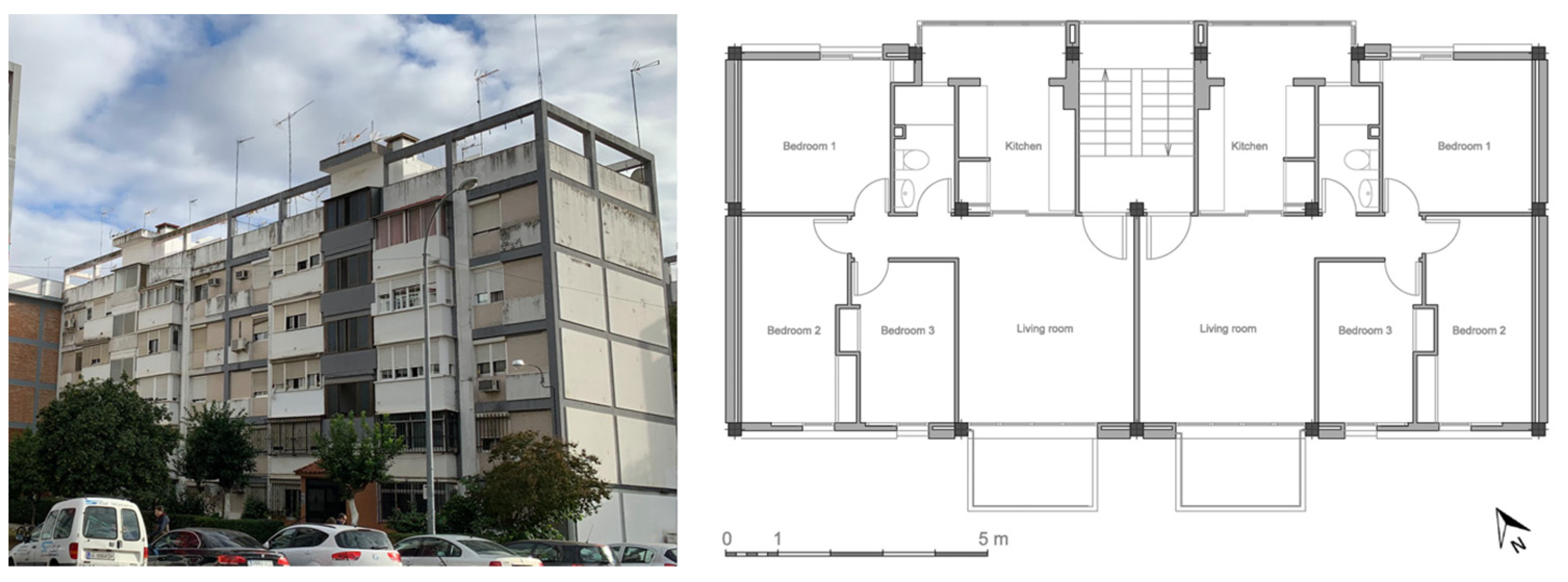
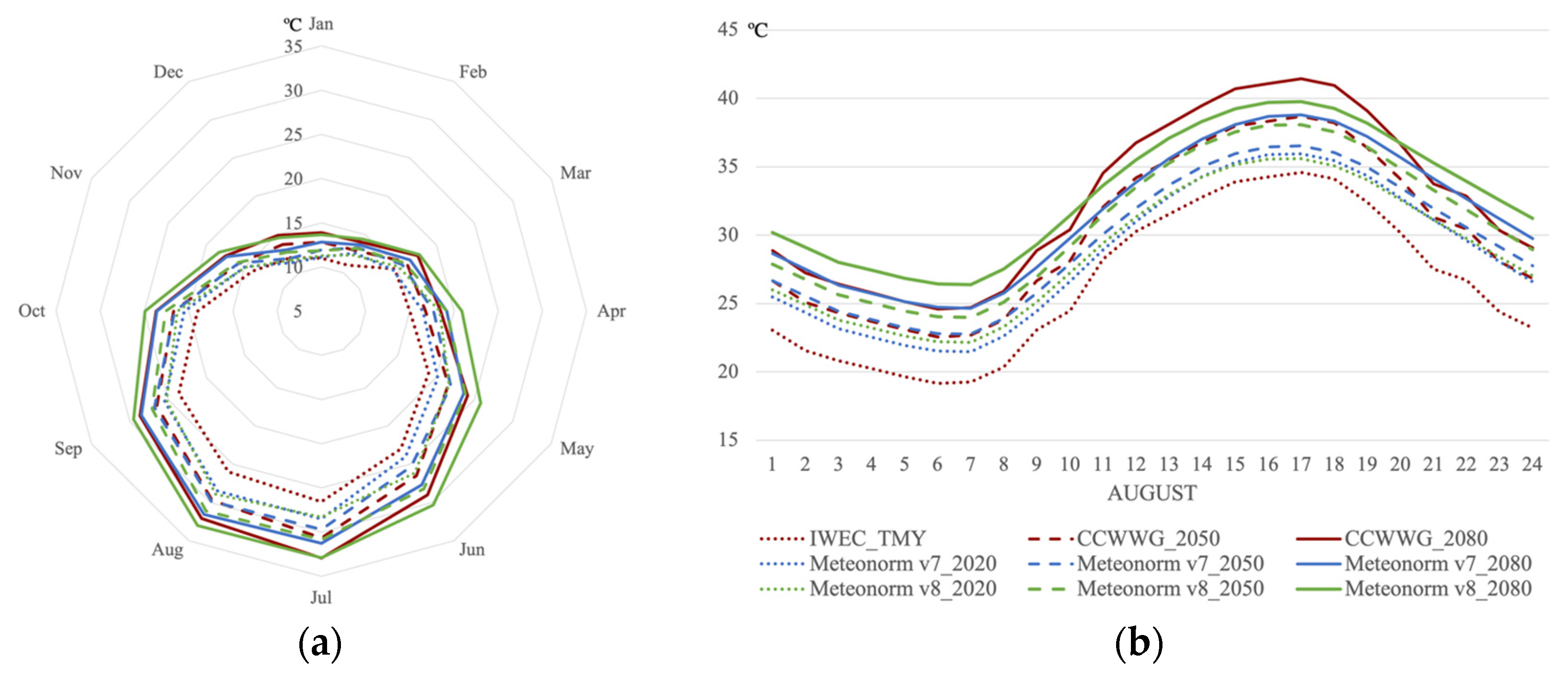
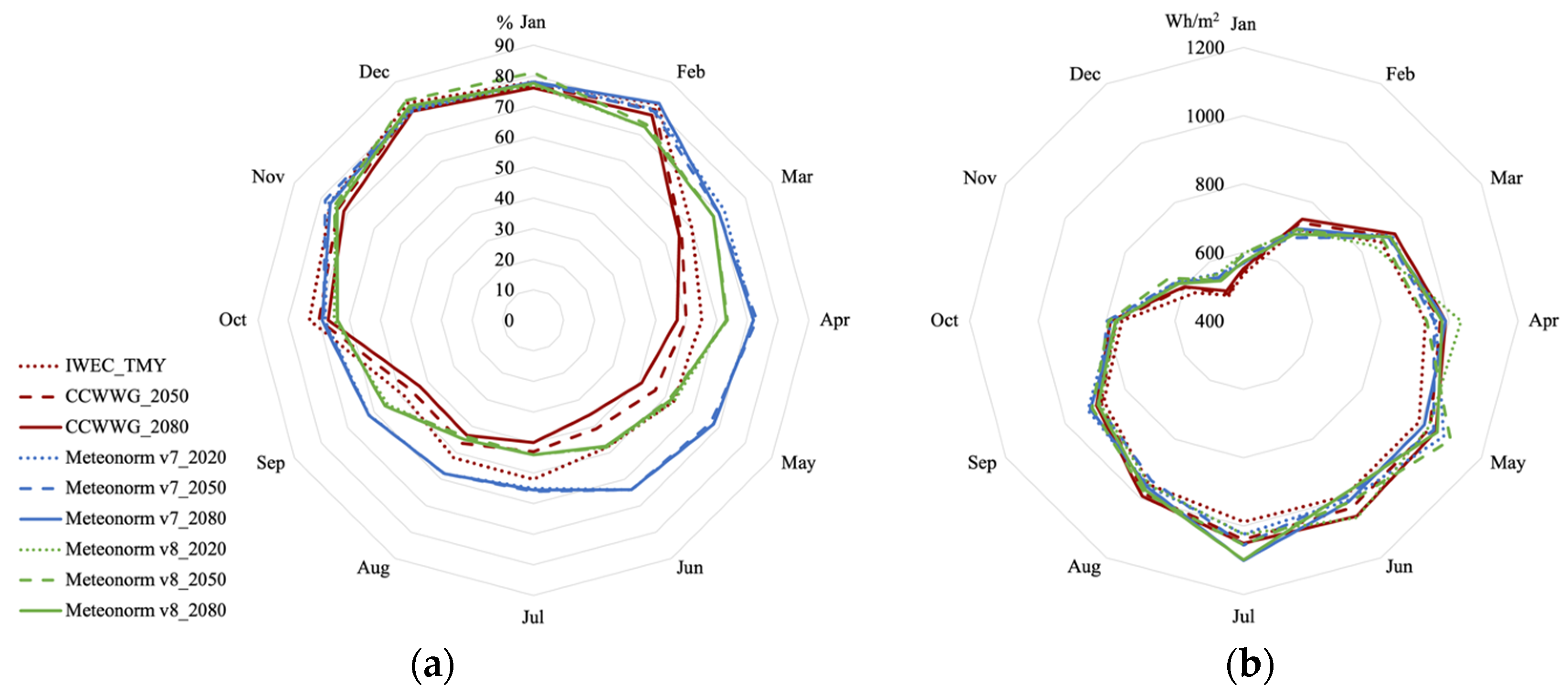
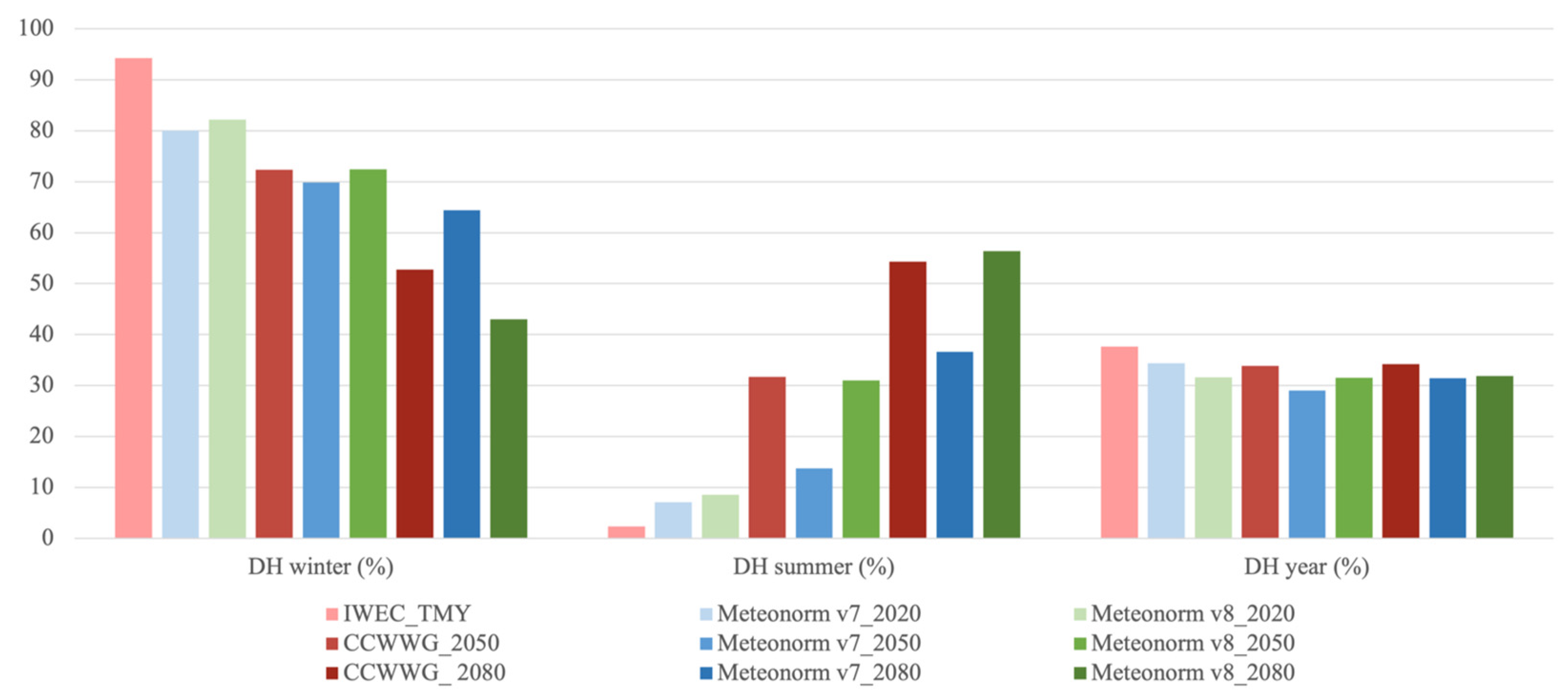
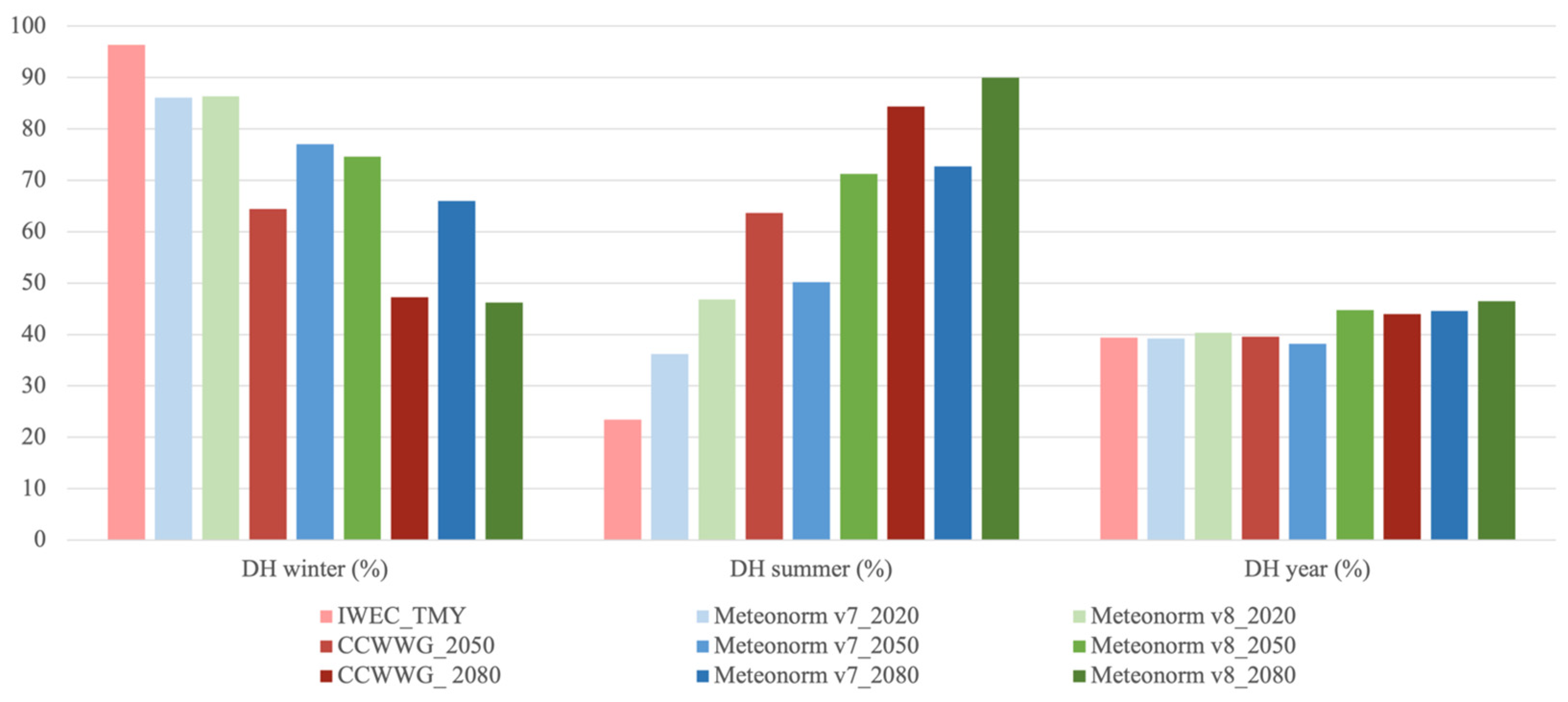
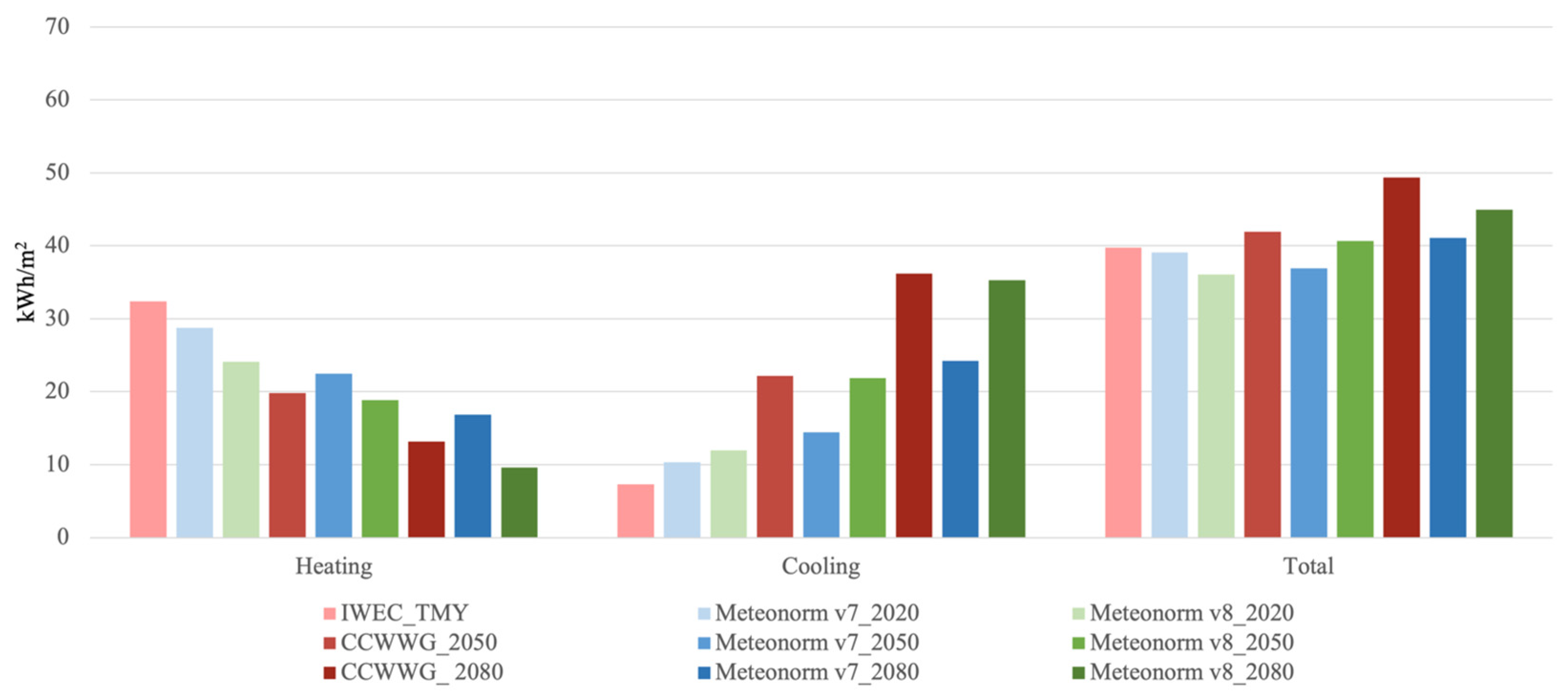
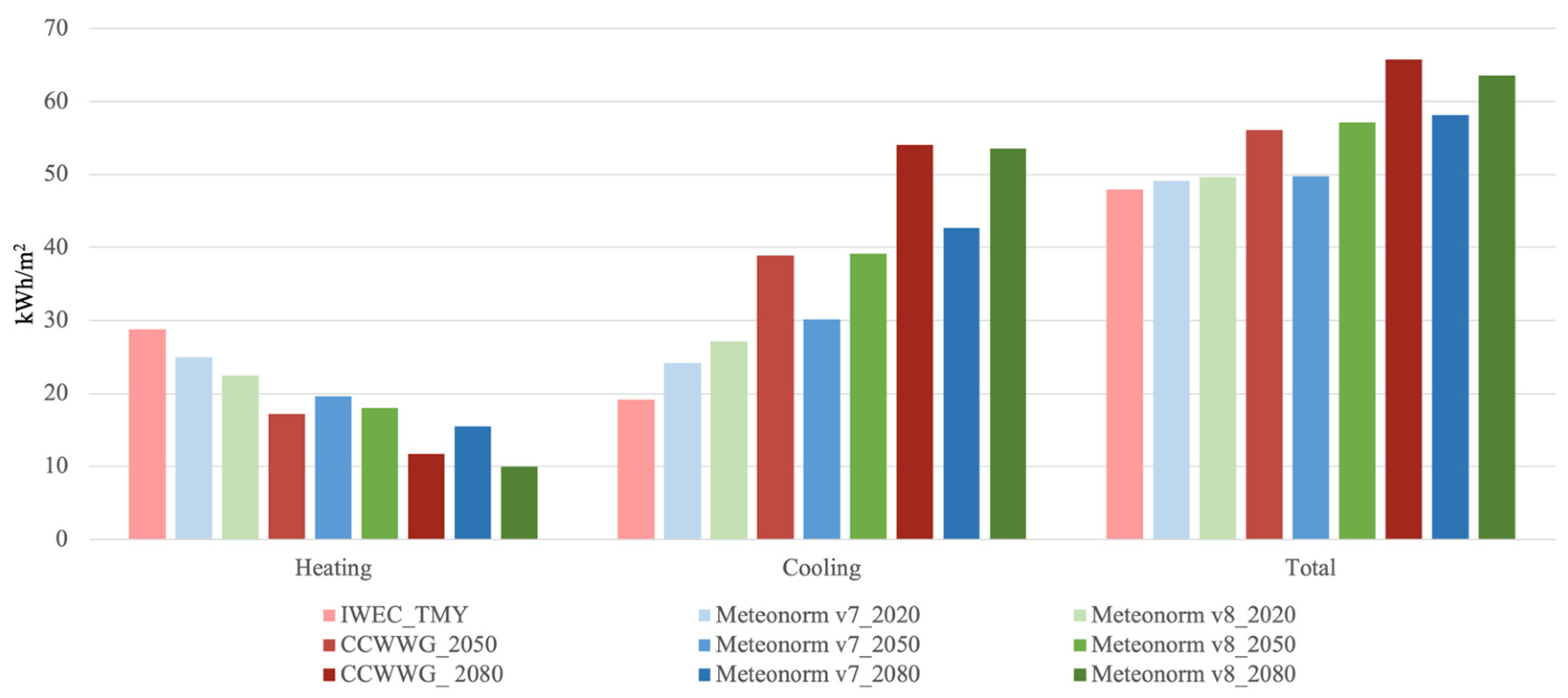
| Pattern | Schedule | |
|---|---|---|
| 23.00–7.00 h | 7.00–23.00 h | |
| Heating | 17 °C | 20 °C |
| Cooling | 27 °C | 25 °C |
| Tool | CGM | Base File 1 | Future Scenarios 1 |
|---|---|---|---|
| CCWorldWeatherGen | HadCM3 | IWEC TMY (1982–2006) | 2050 (2041–2070) 2080 (2071–2100) |
| Meteonorm v7 | HadCM3 | Meteonorm database (2010–2020) | 2050 (2046–2065) 2080 (2080–2099) |
| Meteonorm v8 | RCP8.5 | Meteonorm database (2010–2020) | 2050 (2046–2065) 2080 (2080–2099) |
Disclaimer/Publisher’s Note: The statements, opinions and data contained in all publications are solely those of the individual author(s) and contributor(s) and not of MDPI and/or the editor(s). MDPI and/or the editor(s) disclaim responsibility for any injury to people or property resulting from any ideas, methods, instructions or products referred to in the content. |
© 2023 by the authors. Licensee MDPI, Basel, Switzerland. This article is an open access article distributed under the terms and conditions of the Creative Commons Attribution (CC BY) license (https://creativecommons.org/licenses/by/4.0/).
Share and Cite
Escandón, R.; Calama-González, C.M.; Alonso, A.; Suárez, R.; León-Rodríguez, Á.L. How Do Different Methods for Generating Future Weather Data Affect Building Performance Simulations? A Comparative Analysis of Southern Europe. Buildings 2023, 13, 2385. https://doi.org/10.3390/buildings13092385
Escandón R, Calama-González CM, Alonso A, Suárez R, León-Rodríguez ÁL. How Do Different Methods for Generating Future Weather Data Affect Building Performance Simulations? A Comparative Analysis of Southern Europe. Buildings. 2023; 13(9):2385. https://doi.org/10.3390/buildings13092385
Chicago/Turabian StyleEscandón, Rocío, Carmen María Calama-González, Alicia Alonso, Rafael Suárez, and Ángel Luis León-Rodríguez. 2023. "How Do Different Methods for Generating Future Weather Data Affect Building Performance Simulations? A Comparative Analysis of Southern Europe" Buildings 13, no. 9: 2385. https://doi.org/10.3390/buildings13092385






